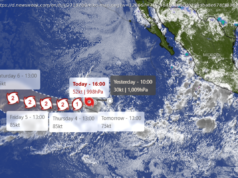The US state was spared a direct hit by a major hurricane, but heavy rains and flooding still pose a risk
Tropical Storm Lane threatened to drench Hawaii’s most populated island of Oahu on Saturday, after lingering just south of the US state and unleashing torrential rains and flooding on the Big Island, weather and civil defence officials said.
Hawaii was spared a direct hit by a major hurricane as Lane, once a monster tempest, weakened on Friday into a tropical storm with sustained winds of 100 kilometres per hour (65 miles per hour).
Early on Saturday it remained south of Hawaii and was moving slowly north-northwest through the Pacific Ocean, its outer rain bands producing severe flooding across parts of the islands.
“Regardless of the storm’s track, life threatening flash flooding, along with locally strong winds and possible isolated tornadoes, will continue to extend far beyond the centre’s location,” the National Weather Service’s Honolulu office said. “Do not focus on the exact forecast track or intensity of Lane.”
Hawaii’s Big Island, properly called the island of Hawaii, was hard hit on Friday and much of it remained vulnerable to flash floods, the weather service said.
Hilo, the Big Island’s largest community, received more than 79 centimetres (31 inches) of rain from Wednesday through Friday, its largest three-day total since records began in 1949. Some areas received more than 45 inches, the weather service said.
Police and emergency crews conducted numerous rescues of people stranded in vehicles and homes by high water on Friday.
On Saturday, Lane was creeping north-northwest at 5km/h (3mph), NWS meteorologist Chevy Chevalier said by phone. It was expected to turn to the west, away from Hawaii, later on Saturday, he said.
“We have to get this thing out of here, and the biggest reason is the Big Island does not need any more rain,” he said.
No injuries were reported, but several structures were destroyed on the Big Island, said Melissa Dye, an NWS spokeswoman in Honolulu.
She said two Hilo-area neighbourhoods were evacuated.
“I’ve never seen this, so much devastation of the river flowing down off of Komohana,” said one long-time Hilo resident, Tracy Pacheco. “I just came from Pahale Park, and there’s no park.”
Oahu, home to the state capital of Honolulu and to 70 per cent of Hawaii’s 1.4 million residents, could receive heavy rain later on Saturday if the storm lingers south of the state, forecasters said.
More than 1,100 people stayed in emergency shelters in the city on Friday, according to its mayor, Kirk Caldwell. He told the Weather Channel that Honolulu is vulnerable to floods and mudslides because it is partly ringed by mountains.
“We have asked our residents in these areas where they know it floods to be ready to leave,” Caldwell said on Friday.
Forecasts predicted that Lane, which peaked as a Category 5 hurricane with top sustained winds of 260kph (160mph) earlier in the week while far from Hawaii, will diminish into a tropical depression by early on Sunday.
New Yorker Rigo Pagoada, 43, who was on holiday on Oahu with his family, said he felt lucky it had been largely spared, but that it was sad to see what had happened on the Big Island.
“We’ve been very fortunate,” Pagoada said.
Hawaii’s major airports stayed open during the storm, though some flights were cancelled at Honolulu’s main airport and at Kahului Airport on Maui.
Travellers should expect congestion at the airports through the weekend as a result, Hawaii Governor David Ige said.






